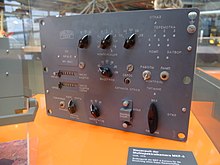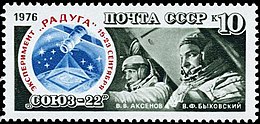|
Soyuz 7K-MF6
Soyuz 7K-MF6 is a version of the Soyuz spacecraft and was the second Soviet spacecraft designed for space station flight, a dedicated science mission. Its only crewed flight was conducted in 1976 with Soyuz 22 of the Soyuz programme.[2] Design and flight
The one craft of the Soyuz 7K-MF6 was modified from the original Soyuz 7K-TM/Soyuz 7K-T with the addition of observatory platform. The Soyuz 7K-MF6 flew once on Soyuz 22. Soyuz 7K-MF6 propulsion was from a KTDU-80, liquid rocket engine. Soyuz 7K-MF6 was the second Soviet manned space observatory, the first was Soyuz 13/Soyuz 7K-T-AF. Soyuz 7K-MF6/Soyuz 2 housed the MKF-6 multi-spectral camera. The spectral camera was used for photography of Earth. The multi-spectral camera was manufactured by Carl Zeiss-Jena in East Germany. The universal docking port was removed and a multispectral camera was installed in its place. The observatory equipment was added to the top of nose cone of the spacecraft. Soyuz 7K-MF6 started as the back up spacecraft for the Apollo–Soyuz project, a Soyuz ASTP craft # 74. The Soyuz ASTP was modified in 1976 to become 7K-MF6, after it was not need for the Apollo–Soyuz project that ended in 1975, which used spacecraft Soyuz 19 and Apollo CSM-111. [4][5] See alsoReferences
External linksWikimedia Commons has media related to MKF 6.
 
|
||||||||||||||||||||||||||||||||||||||||||||||||||||||||||||



